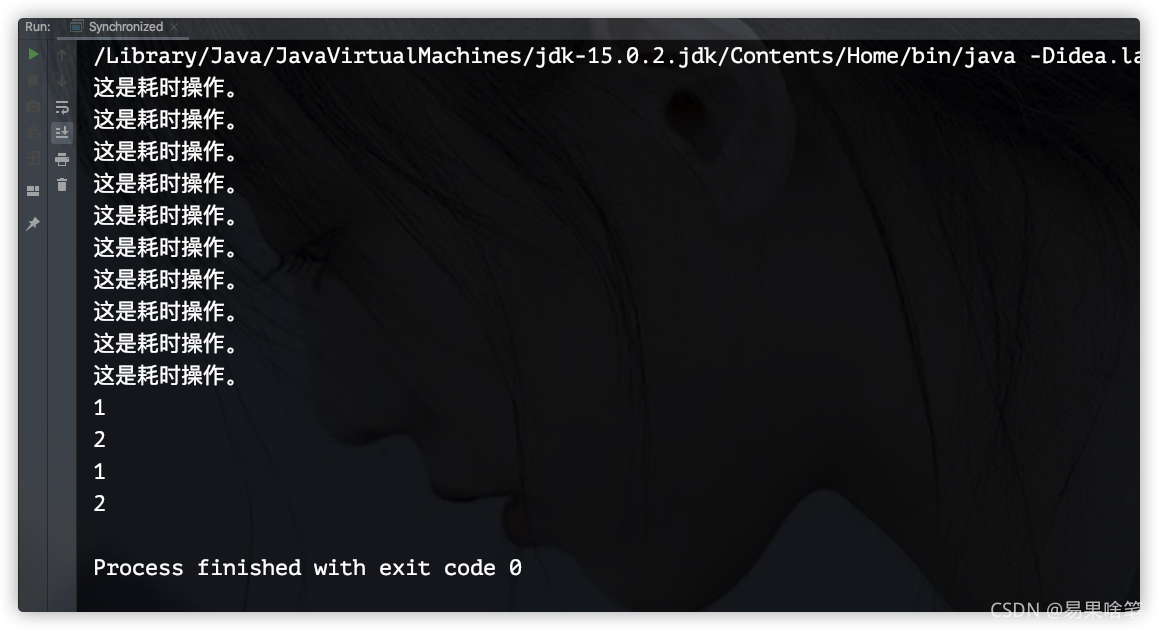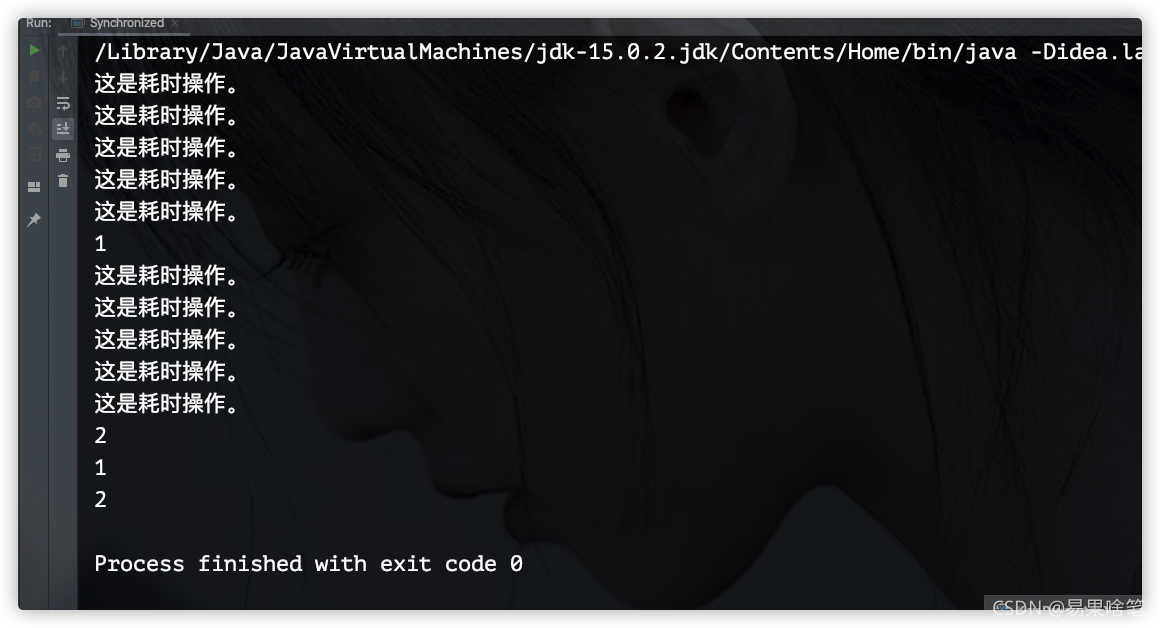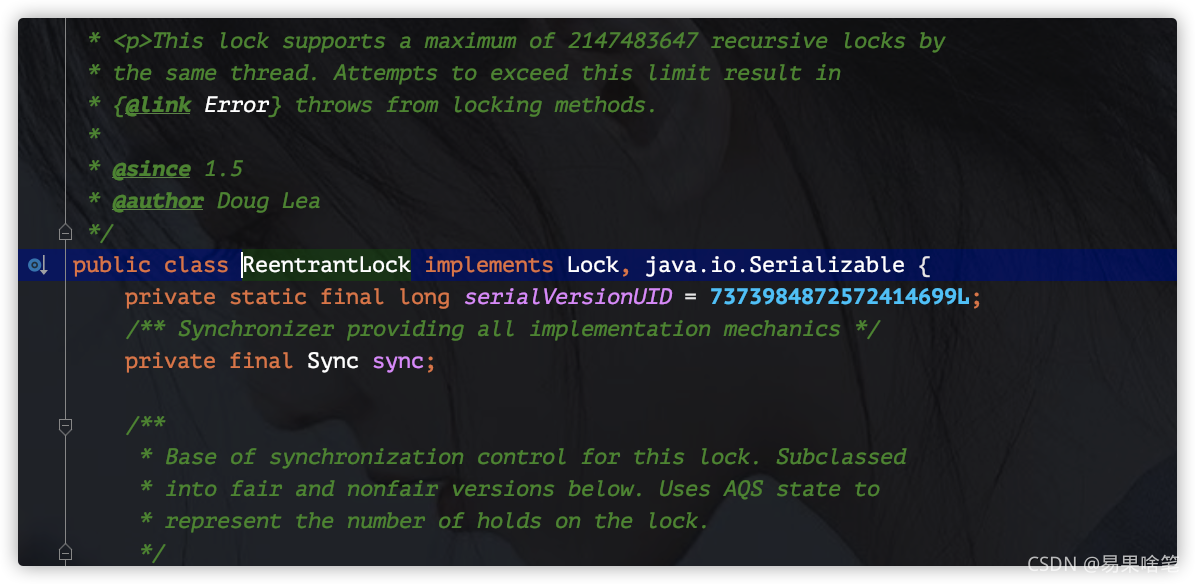前言
上一章,我们通过几个例子介绍了线程安全问题,而说到线程安全就不得不提到线程同步,它是解决线程安全的一种重要方法。本章就来简单地介绍一下线程同步。
从上一章的学习我们知道,当多个线程操作一个资源的时候,有可能由于线程的不确定切换出现数据不一致的安全问题,因此,我们要解决这个问题,就得想办法使得资源在某个时间戳只能被一个线程访问。基于这样的思想,我们提出了“队列与锁”的策略:
通俗理解,就是将所有线程排成一个队列,给要共享的资源上把锁,只有线程获得该资源的锁之后,才能访问该资源。
这也是线程同步的基本思想。所谓线程同步,是指同一进程中的多个线程相互协调工作从而达到一致性。使用线程同步,在解决线程安全问题的同时还能提高程序的性能。
基于“队列与锁”的思想,JDK中封装了一些用于实现线程同步的类和关键字。我们主要介绍synchronized 和 lock 两种。
synchronized
在java中,每个对象都有一把唯一的锁,这也是synchronized实现线程同步的基础。总的来说,synchronized实现线程同步主要有三种形式:
| 形式 |
特点 |
| 实例同步方法 |
锁的是当前实例对象,执行同步代码前必须获得当前实例的锁 |
| 静态同步方法 |
锁的是当前类的class对象,执行同步代码前必须获得当前类对象的锁 |
| 同步代码块 |
锁的是括号里的对象,对给定对象加锁,执行同步代码块必须获得给定对象的锁 |
当两个线程同时对一个对象的某个方法进行调用时,只有一个线程能够抢到该对象的锁,因为一个对象只有一把锁。抢到该对象的锁之后,其他线程就无法访问该对象的所有synchronized方法,但仍可以访问该对象中的非synchronized方法。
下面,我们用代码来演示synchronized的三种用法。为了突出synchronized在线程安全方面的作用,我们采用对比(有synchronized和无synchronized)的方式来介绍。
修饰实例同步方法
首先,来看一个简单的程序:
1
2
3
4
5
6
7
8
9
10
11
12
13
14
15
16
17
18
19
20
21
22
23
24
25
|
public class Synchronized implements Runnable{
static int count = 0;
public void increase(){
count++;
}
@Override
public void run() {
for (int i = 0; i < 10000; i++) {
increase();
}
}
public static void main(String[] args) throws InterruptedException {
new Thread(new Synchronized(),"A").start();
new Thread(new Synchronized(),"B").start();
Thread.sleep(2000);
System.out.println(count);
}
}
|
如果小伙伴们学习了上一章的内容,应该很容易看出这个程序是存在线程安全问题的,它的输出结果如下:

上一篇博文中说到,对于“count++”,JVM是这样处理的:
- 某线程从内存中读取count值到寄存器
- 某线程在寄存器中修改count的值
- 某线程将修改后的count值写入内存
简单解释一下,我们开启了两个线程去执行increase()方法,如果没有任何保护机制,假设,当count的值累加到1000时,A线程从主内存中读取到寄存器的count值为1000,执行完“count++”操作后,寄存器中的count值为1001,刚想写入内存,B线程正好抢到了CPU的使用权,开始执行run()方法,由于未写入内存,B线程从内存中读取到的count值为仍为1000,执行完“count++”操作后,B线程成功地将1001写入内存,接着A线程将自己寄存器中的count值1001写入内存(覆盖了B线程的1001),由此导致,虽然执行了两个线程,但count的值只累加了一次,这样的情况多发生几次,计算结果自然就低于20000了。
为了避免以上情况发生,我们给increase()方法加上修饰符synchronized,使得两个线程无法同时调用increase()方法,以保证上面的三步中的任何一步都不会被另外一个线程打断。
这样,“count++”操作就永远不会因线程切换而出错。代码如下:
1
2
3
4
5
6
7
8
9
10
11
12
13
14
15
16
17
18
19
20
21
22
23
24
25
26
|
public class Synchronized implements Runnable{
static int count = 0;
public synchronized void increase(){
count++;
}
@Override
public void run() {
for (int i = 0; i < 10000; i++) {
increase();
}
}
public static void main(String[] args) throws InterruptedException {
new Thread(new Synchronized(),"A").start();
new Thread(new Synchronized(),"B").start();
Thread.sleep(2000);
System.out.println(count);
}
}
|
现在来看运行结果:
 没有任何问题。
没有任何问题。
此外,使用synchronized时,有几个需要注意的地方,请看下面的代码:
1
2
3
4
5
6
7
8
9
10
11
12
13
14
15
16
17
18
19
20
21
22
23
24
25
26
27
28
|
public class Synchronized implements Runnable{
public synchronized void running() throws InterruptedException {
System.out.println("1");
Thread.sleep(1000);
System.out.println("2");
}
@Override
public void run() {
try {
running();
} catch (InterruptedException e) {
e.printStackTrace();
}
}
public static void main(String[] args) throws InterruptedException {
Synchronized sync1 = new Synchronized();
new Thread(sync1).start();
Synchronized sync2 = new Synchronized();
new Thread(sync2).start();
}
}
|
如果我们使用不同的对象访问,那么结果有可能是不同步的:
 因为
因为synchronized修饰实例方法时锁的对象是this对象,而使用两个对象去访问,不是同一把锁。如果我们用同一对象访问:
1
2
3
4
|
Synchronized sync = new Synchronized();
new Thread(sync).start();
new Thread(sync).start();
|
那结果是同步的:

synchronized修饰静态方法
1
2
3
4
5
6
7
8
9
10
11
12
13
14
15
16
17
18
19
20
21
22
23
24
25
26
27
28
29
|
public class Synchronized implements Runnable{
public static synchronized void running() throws InterruptedException {
System.out.println("1");
Thread.sleep(1000);
System.out.println("2");
}
@Override
public void run() {
try {
running();
} catch (InterruptedException e) {
e.printStackTrace();
}
}
public static void main(String[] args) throws InterruptedException {
Synchronized sync1 = new Synchronized();
new Thread(sync1).start();
Thread.sleep(2000);
Synchronized sync2 = new Synchronized();
new Thread(sync2).start();
}
}
|
虽然有sync1,sync2两个对象,但是它们是同一个类对象(Synchronized.class)产生的,而synchronized修饰静态方法时,锁的是 Synchronized.class,因此两个线程仍然是同步的:

synchronzied修饰同步代码块
它可以锁任何指定的对象,语法示例如下:
1
2
3
4
5
| synchronized (this){
System.out.println("1");
Thread.sleep(1000);
System.out.println("2");
}
|
this指代当前实例对象,可以换为任何对象。
那么为什么要使用同步代码块呢?
在某些情况下,我们编写的方法体可能比较庞大,同时又有一些耗时的操作,如果对整个方法体进行同步,效率会大大降低,所以我们希望能够只同步必要的代码块,对于一些不需要同步的或者耗时较长的操作,放到同步代码块之外,比如:
1
2
3
4
5
6
7
8
9
10
11
12
13
14
15
16
17
18
19
20
21
22
23
24
25
26
27
28
29
30
31
32
|
public class Synchronized implements Runnable{
public void running() throws InterruptedException {
for (int i = 0; i < 5; i++) {
System.out.println("这是耗时操作。");
}
synchronized (this){
System.out.println("1");
Thread.sleep(1000);
System.out.println("2");
}
}
@Override
public void run() {
try {
running();
} catch (InterruptedException e) {
e.printStackTrace();
}
}
public static void main(String[] args) throws InterruptedException {
Synchronized sync = new Synchronized();
new Thread(sync).start();
new Thread(sync).start();
}
}
|
运行结果如下:
 再运行一次:
再运行一次:
 结果表明,需要同步的代码块确实实现了同步。
结果表明,需要同步的代码块确实实现了同步。
lock
前面使用的synchronized关键字可以实现多线程间的同步互斥,其实,在JDK1.5后新增的ReentrantLock 类同样可以实现这个功能,而且在使用上比 synchronized 更为灵活。
翻阅源码,可以看到 ReentrantLock 类实现了Lock接口:

下面我们用ReentrantLock类来实现简单的线程同步:
1
2
3
4
5
6
7
8
9
10
11
12
13
14
15
16
17
18
19
20
21
22
23
24
25
26
27
28
29
30
31
32
33
34
35
36
37
| import java.util.concurrent.locks.Lock;
import java.util.concurrent.locks.ReentrantLock;
public class LockDemo implements Runnable{
private Lock lock = new ReentrantLock();
@Override
public void run() {
lock.lock();
try {
for (int i = 0; i < 5; i++) {
System.out.println(Thread.currentThread().getName() + "线程中的i=" + i);
}
} catch (Exception e) {
e.printStackTrace();
} finally {
lock.unlock();
}
}
public static void main(String[] args)
new Thread(new LockDemo(),"A").start();
new Thread(new LockDemo(),"B").start();
}
}
|
其实关于Lock 和 ReentrantLock,还有许多其他的用法,限于篇幅,就不一一介绍了,有兴趣的小伙伴们可以查阅相关资料。
线程同步示例
了解了synchronized和ReentrantLock,对于上一章提出的三个线程安全问题,便可以轻松地解决了。下面提供使用synchronized的解决方式:
1
2
3
4
5
6
7
8
9
10
11
12
13
14
15
16
17
18
19
20
21
22
23
24
25
26
27
28
29
30
31
32
33
34
35
36
37
38
39
40
41
42
43
44
45
46
47
48
49
50
51
52
53
54
55
56
57
58
59
60
61
|
public class UnsafeBank {
public static void main(String[] args) {
Account account = new Account(100,"买房基金");
Drawing you = new Drawing(account,50,"你");
Drawing girlFriend = new Drawing(account,100,"妻子");
you.start();
girlFriend.start();
}
}
class Account{
int money;
String name;
public Account(int money,String name){
this.money = money;
this.name = name;
}
}
class Drawing extends Thread{
Account account;
int drawingMoney;
int nowMoney;
public Drawing(Account account,int drawingMoney,String name){
super(name);
this.account = account;
this.drawingMoney = drawingMoney;
}
@Override
public void run() {
synchronized (account){
if(account.money - drawingMoney < 0){
System.out.println(Thread.currentThread().getName() + "钱不够了,取不了!");
return;
}
try {
sleep(3000);
} catch (InterruptedException e) {
e.printStackTrace();
}
account.money = account.money - drawingMoney;
nowMoney = nowMoney + drawingMoney;
System.out.println(account.name + "余额为:" + account.money);
System.out.println(Thread.currentThread().getName() + "手里的钱:" + nowMoney);
}
}
}
|
1
2
3
4
5
6
7
8
9
10
11
12
13
14
15
16
17
18
19
20
21
22
23
24
25
26
27
28
29
30
31
32
33
34
35
36
37
38
39
40
41
42
43
|
public class UnsafeBuyTicket {
public static void main(String[] args) {
BuyTicket buyTicket = new BuyTicket();
new Thread(buyTicket,"小红").start();
new Thread(buyTicket,"小白").start();
new Thread(buyTicket,"小黑").start();
}
}
class BuyTicket implements Runnable{
private int tickets = 10;
private boolean flag = true;
private synchronized void buy() throws InterruptedException {
if(tickets <= 0){
flag = false;
return;
}
Thread.sleep(20);
System.out.println(Thread.currentThread().getName() + "拿到了第" + tickets-- +"张票");
}
@Override
public void run() {
while (flag){
try {
buy();
} catch (InterruptedException e) {
e.printStackTrace();
}
}
}
}
|
1
2
3
4
5
6
7
8
9
10
11
12
13
14
15
16
17
18
19
20
21
22
23
24
25
26
| import java.util.ArrayList;
import java.util.List;
public class UnsafeList {
public static void main(String[] args) throws InterruptedException {
List<String> list = new ArrayList<String>();
for (int i = 0; i < 10000; i++) {
new Thread( () -> {
synchronized (list){
list.add(Thread.currentThread().getName());
}
}).start();
}
Thread.sleep(3000);
System.out.println(list.size());
}
}
|
小伙伴们可以思考一下如果使用ReentrantLock应该如何解决。
下一章,我们将着重介绍Thread类中的一些常用方法,好啦~本章的内容到这就结束了。

 没有任何问题。
没有任何问题。 因为
因为

 再运行一次:
再运行一次: 结果表明,需要同步的代码块确实实现了同步。
结果表明,需要同步的代码块确实实现了同步。

